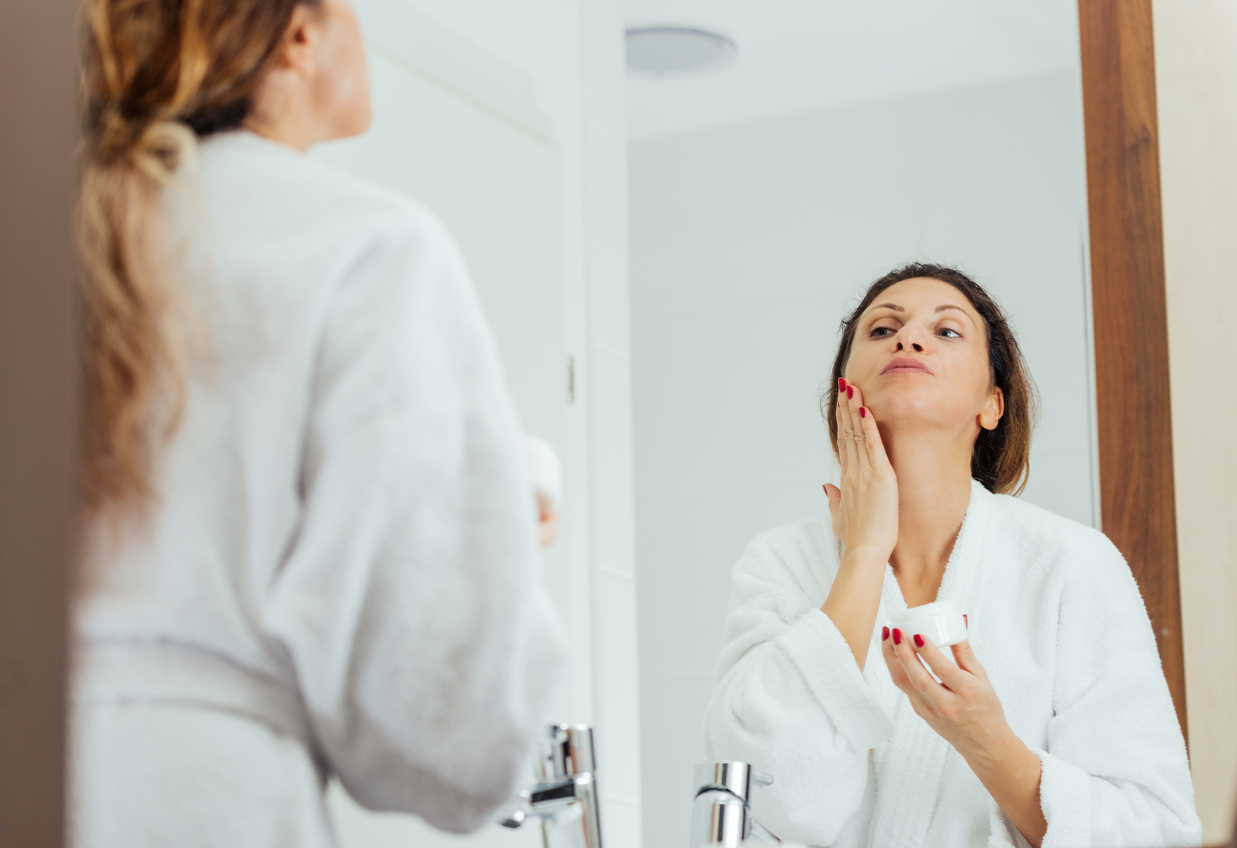Skin aging and wrinkles
Many factors contribute to skin aging. Some of them, referred to as exogenous factors, come from the external environment. The main one is UV radiation, which is one of the leading culprits behind skin aging. External factors also include free radicals emitted from car exhausts, as well as tobacco and industrial smoke. In contrast to the above-mentioned factors, endogenous factors are genetically determined and are based on processes taking place inside the body. However, all of them, regardless of their origin, lead to visible changes in the skin, such as wrinkles, loss of firmness or elasticity.
Skin regeneration
The human body has defence mechanisms that, to some extent, reduce the aging process. Skin is protected by such factors as increased production of melanin after exposure to solar radiation, and the body's natural antioxidant substances, especially vitamins E and C. The skin also orchestrates the DNA repair process and regulates lipid synthesis, which rebuilds the damaged skin barrier. All of these natural repair processes, however, are insufficient when the skin is excessively exposed to aging factors. Also, these processes weaken over time. The answer to this problem can be found in beauty products that effectively mimic these skin defence mechanisms. A beauty product is said to have anti-aging properties when it protects the skin against UV radiation and free radicals, while stimulating and regulating skin renewal.
Sun protection
The substances that provide protection against UV radiation in anti-aging cosmetics are of course filters, both chemical and physical, that act like a screen reflecting the sun's rays from the skin. Of the synthetic ones, the most popular are octyl methoxycinnamate (INCI: Octyl Methoxycinnamate), benzophenone-3 (INCI: Benzophenone-3) and butyl methoxydibenzoylmethane (INCI: Butyl Methoxydibenzoylomethane). The most common minerals are titanium dioxide (INCI: Titanium Dioxide) and zinc oxide (INCI: Zinc Oxide). Anti-aging cosmetics also use natural raw materials that have sunscreen properties, for example aloe juice, plant extracts containing ferulic or caffeic acid, and certain fats, such as shea or cocoa butter. However, chemical filters are the most affective.
Skin moisturising
The basis of anti-wrinkle care is proper moisturising. This is important regardless of age, because dehydration sensitises the skin to aging factors. Effective moisturising consists of regenerating the lipid layer of the skin and strengthening its protective functions. Moisturising beauty products should be selected according to your skin type. Fortunately, pharmacies and drugstores offer a very wide range of products. Among the ingredients look for hyaluronic acid, which acts as a "moisture magnet". Urea, lactic acid, glycerine and propylene glycol are also effective. To effectively seal the protective barrier of the skin, reach for cosmetics containing physiological lipids, i.e. ceramides, squalene, triglycerides, phospholipids or fatty acids. Other valuable ingredients include hydrolysates, including the hydrolysate of wheat, rice, soy or silk proteins. They stay on the surface of the skin, which makes them ideal for moisturising.

Anti-oxidation for the skin
Among the antioxidant substances, vitamin E and its derivatives deserve special attention. These compounds work in two ways: they supplement the lipid deficiencies in the stratum corneum of the skin and protect the lipids of intercellular cement against oxidation of unsaturated fatty acids. In this way, they improve skin flexibility and softness. Another "youth vitamin" found in anti-aging cosmetics is vitamin C. It not only has anti-radical properties, but also helps stimulate collagen synthesis. The basic problem, however, is the hydrophilic nature of this vitamin. It prevents the penetration of valuable substances into the dermis, where collagen synthesis takes place. To eliminate these problems, beauty products include a vitamin C and palmitic acid compound, vitamin C palmitate, which can penetrate the deeper layers of the skin.
The method of trapping vitamin C inside microscopic systems called liposomes is also used, which facilitates its transfer. An example of very strong antioxidants are flavonoids. The seeds and skins of certain plants contain them in large amounts. The most flavonoids are found in green tea, grape seeds, Japanese ginkgo, arnica and marigold. Flavonoids exhibit stronger antiradical activity than the above-mentioned vitamins, so look for them as ingredients in beauty products. The coenzyme Q, or ubiquinone, plays an important role in anti-oxidative processes. This compound is called the elixir of youth for a reason, because it effectively inhibits the aging process. It helps cells get rid of reactive oxygen species, which contribute to skin aging. Beauty products containing this compound are very effective.
Stimulation of skin renewal
The leading anti-aging substances are retinoids, or derivatives of vitamin A. Their wrinkle reducing, skin smoothing and softening properties have been confirmed by numerous studies. Retinol and retinal are the most common retinoids in beauty products. Due to their lipophilic nature, these substances easily penetrate the epidermis barrier and affect the entire dermis. Creams containing retinoids are intended for mature skin, with visible and established wrinkles. By stimulating skin renewal processes, they have a strong regenerating effect. It is worth adding that retinoids also prevent excessive loss of water from the epidermis, which is important in inhibiting the formation of new wrinkles. A group of substances often used in anti-aging products are alpha-hydroxy acids (AHA). They help achieve a younger, refreshed look, improve skin tone, as well as increase skin hydration and elasticity. By loosening the bonds between the stratum corneum, they exfoliate the epidermis, which in turn helps intensify cell division. This results in rapid skin renewal and the reduction of wrinkles.
Super ingredients to fight wrinkles
In recent years, low molecular weight biomimetic peptides have been used as ingredients in anti-aging products. These are combinations of several amino acids that are similar to human peptides. The activity of these compounds has been confirmed by application tests. The biomimetic peptides help eliminate age-induced signals that stimulate myofibroblast contraction, and thus reduce mimic wrinkles. A valuable source of anti-aging substances are algae. In cosmetology, the most common types are Laminaria, Fucus, Spirulina and Chlorella. They contain large amounts of polysaccharides, mineral salts, carotenoids and other valuable substances, thanks to which they increase the synthesis of collagen and elastin.
Oral supplementation against wrinkles
The skin's anti-radical resistance decreases with age. In addition to beauty products, oral supplements may be used to supplement the deficiencies of valuable antioxidants, which will additionally strengthen their effect. According to research, the following ingredients have anti-aging properties: vitamin E, plant extracts containing flavonoids (green tea, grape seeds, pycnogenol), as well as beta-carotene, lycopene and lutein. All these substances are widely available in the form of pharmaceutical supplements.




